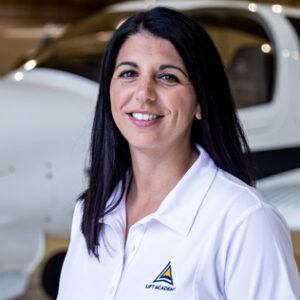
Dana Donati gives testimony for part 147 curriculum in Washington D.C.
This past February, Dana Donati, LIFT Academy General Manager and Director of Academic Programs, represented LIFT, Republic Airways and flight schools across the U.S. before the U.S. House Subcommittee on Aviation to petition for the modernization of Title 14 Code of Federal Regulations (CFR) part 147 curriculum.
Title 14 CFR part 147 governs aviation maintenance technician (AMT) schools that hold a Federal Aviation Administration (FAA) Certificate. Part 147 was written into regulation in 1962. Since then, there have been innumerable changes to the mechanics and technology that are used in planes, but there have been no changes to the FAA-mandated curriculum taught at AMT schools.
With the support of the Regional Airline Association, Dana spoke to the Subcommittee on to the need to update part 147 and why LIFT is well suited to make the new changes “overnight.”

Dana Donati, General Manager and Director of Academic Programs
Q: Can you share an overview as to why you went to Washington D.C.?
A: I had the support of Republic and the Regional Airline Association, who prepped me for my testimony in front of the U.S. House Subcommittee of Aviation. When I was asked to represent Republic and LIFT, it was to really emphasize three specific things:
- Federal financial aid.
- Antiquated part 147 curriculum.
- More structured training.
Q: What did you say about federal financial aid?
A: Federal financial aid should be increased for aviation. Currently, aviation college students going through a four-year degree program or two-year degree program will not receive enough financial aid to pay for the entire aviation degree. This really eliminates people from being able to complete a degree. This is eliminating people who wish to pursue flying as a career from even beginning and adds a large barrier that few may be able to overcome.
Q: What about part 147 curriculum?
A: Another part of my testimony was about the part 147 curriculum, which is the curriculum taught to AMTs maintenance training programs. At LIFT, we have an AMT apprenticeship program, and we must meet the requirements of part 147, but we have the flexibility to quickly adapt to any changes the FAA may implement. Unfortunately, the FAA hasn’t changed their material in over 60 years. This means that a lot of schools are operating off of an antiquated curriculum. We are taking the approach that we want our AMT apprentices to work on technologically advanced aircraft and high-tech avionics. At LIFT, we’re still meeting the part 147 requirements by teaching all of the antiquated information. But we’re really driving home the importance of the new updated, high-tech information that’s needed for today’s AMTs.
Q: And what about structured training?
A: The final part was to discuss the need for more structured flight training for pilots. If we truly are preparing pilots for the airlines, how can we ensure that, yes, we’re meeting the time requirements required by the FAA but also that they’re fully prepared for the career. We want to make sure that the pilots aren’t going into the career not ready to adapt to behavior of a career pilot.
Q: What was it like being in the room that you were presenting?
A: At first I thought it was going to be intimidating. But when I walked in, it really wasn’t. It was extremely cool. If you watch C-SPAN you’ve seen video of congressional committees meeting in the Rayburn Building in Washington, D.C. And again, they look intimidating. There are very powerful people sitting there in front of you, but they are there helping to ask the right questions to help make decisions.
And being a part of that experience, of providing them with all the information I could, to help them make the decision that’s best for the industry, that was a cool experience.
Q: What did you do to prepare to speak to this group?
A: With a small amount of time to prepare, the Regional Airline Association was helpful in preparing me for this experience. I knew what I wanted to say in terms of changes and what we are doing at LIFT and Republic Airways, but they know how to best present information and interact in Washington D.C., working with Congress all the time. We did a pre-testimonial Q&A session so I would be prepared to answer the types of questions that I would be asked during the hearing. We did a lot of prepping; it was kind of like preparing for a check ride.
Q: Were you the only person there presenting on this topic to the U.S. House Subcommittee on Aviation?
A: I presented on behalf of Republic Airways and LIFT Academy. I was a part of a panel of industry experts ranging from education to major airline representatives.
Q: Do you feel that you were the right person to talk on this? Why?
A: I am fortunate to work with a team of passionate aviation experts, and everyone I work with has the knowledge to speak on what the industry needs Congress to review. Anyone at LIFT Academy or Republic Airways could go in there and drive home the same message. I was honored to be asked and accepted the opportunity to be a part of this. The passion that I have and that of my team represents the good that we’re doing within the industry.





